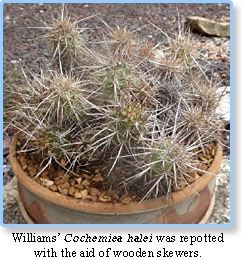– Cochemiea halei (2016)
 By Bob Williams (October 2016)
By Bob Williams (October 2016)
Cochemiea halei was the main attendance “prize” at the June club meeting. A few names were called, and members passed on this plant. I’m not sure of the reason, but I can imagine that the idea of repotting this cactus brings memories of many bandages and a vocabulary most of us do not use in everyday life. I decided to take the plunge and selected this beauty anyway.
Cochemiea is a small genus of only five species. They are found in the Baja California peninsula of Mexico. They are similar to mammillarias in many ways, and some think that these five species should be included in the Mammillaria genus.
Some of the characteristics of the genus are that they form tight clusters that can resemble Mammillaria or Echinocereus plants. These clusters can reach 3 feet in diameter. Spines are white and hooked, except in C. halei, which has straight spines. All five species have dense spination. The flowers for all five species are a deep red. Pollination is done mainly by hummingbirds.
Cochemieas grow in the lower elevations in the Baja at less than 750 feet in elevation. They grow in sandy soils and can be found in rock outcroppings. They can take direct sun and survive with little water. In habitat, these cacti experience a long winter dry season, which does not seem to be critical in cultivation. However, if they are kept dry for several months, a good watering during the hot season will trigger a big flush of bloom that lasts about two weeks. With regular watering they tend to flower sporadically and sparsely over a longer period.
Cochemiea halei is found on the islands of Santa Margarita and Magdalena, which are Pacific islands off Baja California. The plants grow in the sand dunes along the coast. They can form clumps 2 to 3 feet in diameter. A single plant will take two to three years before it starts to clump. After that, clumping will be fairly rapid.
When growing this plant in a container, the soil mix should contain more rock or gravel than normal. It can be prone to rot if slightly underpotted. An extremely fast-draining mix can help prevent this.
Cochemiea halei can tolerate freezing temperatures for a very short period of time, but is not a winter-hardy cactus. Propagation can be by cuttings or seeds. Seeds will geminate in seven to 14 days. Cuttings will root in two to six weeks.
